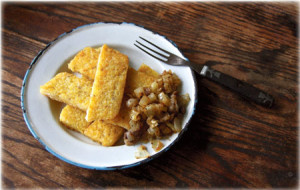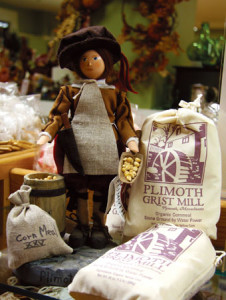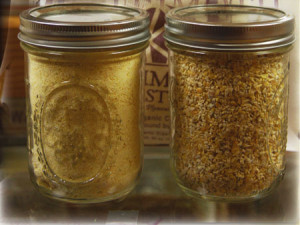by Paula Marcoux.
Although we don’t remember it, we New Englanders used to eat hominy grits with at least as much enthusiasm and dedication as Southerners, only we termed our staple food samp, hasty-pudding, suppawn, mush*. Today, most all these words are liable to be met with blank stares, while only the theoretically exotic polenta gets a rush of recognition. But, naming issues aside, there’s no denying that this dish, simple to make and served morning, noon, and night on most tables in our region for centuries, has fallen completely off the menu.
I’m a fiend for the stuff, whether it’s served classic New England style with molasses and milk, or as Romanian mamaliga with feta cheese and butter broiled on top and roasted red peppers on the side. Heck, when I lived in deepest Georgia I even learned to perversely love Waffle House’s wan, characterless instant grits, served in a butter-dotted puddle napped around an omelet oozing American “cheese” (still perfectly square, even after melting). But when you can get the good stuff—freshly ground corn, milled coarse enough for some real texture in the mouth—you begin to understand how our forebears were happy to see it at every meal.
So it’s wonderful that Kim van Wormer, the miller and manager of Plimoth Plantation’s newest foray, the Plimoth Grist Mill, is putting as much effort into her samp as her also-delicious, finely-textured cornmeal. There are a few other local stalwarts milling great cornmeal—for example Gray’s Mill in nearby Adamsville, R.I.—but as far as I can tell the Plymouth living history attraction may be selling the only stone-ground grits (okay, samp) in the Northeast.
For the moment Kim is sourcing organic whole corn from out of state, but she hopes to forge an alliance with a local farmer interested in growing organic heritage-variety corn for the mill. By summer 2014, it is to be hoped that one of our neighbors here on the South Shore or South Coast will be tending a crop planted from seed not so different from that bred by the Wampanoag women who set their corn and pounded it to samp along the banks of Town Brook before the European incursion in the early seventeenth century.
Both the cornmeal and samp are milled by the power of Plymouth’s Town Brook from organic whole corn and come packed in cute reusable cotton sacks.
*An unscientific survey of corn-nomenclature in cookbooks and other written sources seems to indicate that until about 150 years ago, “mush” ruled over “grits,” even in the South.
Plimoth Grist Mill
6 Spring Lane
Plymouth, MA 02360
(508) 746-1622 x8358
www.plimoth.org
Paula Marcoux is a food historian and writer who lives in Plymouth and at www.TheMagnificentLeaven.com.








